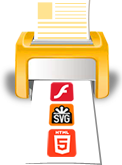Designing your Own Document Viewer for Single File per Page Format
![]()
![]() This approach assumes that the document is stored not in a single SWF file
but in a set of files, each document page being stored in a separate SWF file.
The number of files constituting a document corresponds to the number of pages
in the document. Your responsibility is to develop a viewer which loads document
page files into it and displays them as you need it.
This approach assumes that the document is stored not in a single SWF file
but in a set of files, each document page being stored in a separate SWF file.
The number of files constituting a document corresponds to the number of pages
in the document. Your responsibility is to develop a viewer which loads document
page files into it and displays them as you need it.
The generated document page file is a regular SWF movie file containing a single frame which, when loaded, displays page content. The movie dimensions depend on the original document page size and on the resolution the document was printed at. You may determine the page movie width or height using the following formula:
Dimension (in pixels) = Dimension (in inches) * OutputResolution (in DPI)
Here Dimension (in pixels) represents a page movie width or height, Dimension (in inches) represents the corresponding dimension of this page in inches in the original document and OutputResolution is the value of the Output Resolution field in the Flash Output tab of Document Options window. For example, if the original page height is 11 inches and OutputResolution is set to 192 DPI, the output page Flash file height will be 2112 pixels.
Besides Output Resolution there is also another Resolution setting available in the Printer Properties window. This value differs from the Output Resolution in that it determines the resolution at which applications print documents on the Print2Flash Printer, and this may affect rendering algorithms, speed and quality of those applications at printing. After the application has printed a page, Print2Flash scales the output page to the value specified by the Output Resolution field which may either compress or enlarge page dimensions according to your needs.
In most cases, however, it is better to have both these resolution settings equal to each other unless you are concerned with printing application behavior at various resolutions. To ensure this, OutputResolution property can be set to zero value which means that output resolution is always equal to printing resolution so no additional scaling occurs.
The page movie files are named according to a name template. This template usually consists of a fixed part and a variable page number part. For example, a three page document may consist of three files:
mydoc_1.swf
mydoc_2.swf
mydoc_3.swf
Here the first file corresponds to the first page, the second file - to the second page and so on.
At programmatic conversion file naming is controlled by PageFileName property of Profile object or PageFileName option of Enhanced Batch Processing. The file name contains two placeholders for inserting the output document file name and a page number. For example, to create the above set of files when output document name is mydoc.swf, you need to have this value for the PageFileName property:
%name%_%page%.swf
When converting documents manually, the files are named in a similar way and stored in the folder you specify when saving the Flash document in the Print2Flash Application.
You may determine the total number of pages in the document using TotalPages property of Server object or from a document metadata file.
When developing your own viewer for "Single file per page" mode you need to load these page files in your viewer and display them in whatever way you need it. Print2Flash SDK contains a sample of such a viewer. This sample viewer represents a Flash movie designed in Adobe Flash CS3 Professional software using ActionScript 3. We recommend to check this movie source code for more details, and you may use it as a starting point for developing of your own viewer. The sample uses the standard ScrollPane component for displaying document pages in an area where a continuous stack of document pages can be scrolled. Of course, you may use other methods for document display loading document pages not into ScrollPane component but into other movie clips.
Note that in this mode no skin information is stored in the output page Flash files. They have only actual page content in them.



